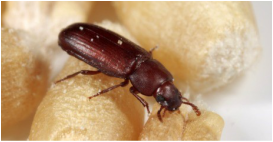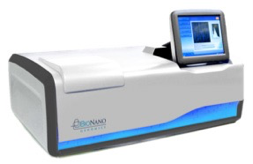 The red flour beetle consuming stored grain The red flour beetle consuming stored grain Today, the red flour beetle, Tribolium castaneum, is not only a ravenous stored grain-eating pest, it is also a model organism for different study areas. Dr. Sue Brown is a University Distinguished professor of Kansas State University focusing on Genomics and Bioinformatics of Tribolium castaneum as a model system. She spent the beginning of her scientific career developing this beetle as a model for studying evolution of gene regulatory networks. She woke up every morning curious about the development and evolution of these charismatic little beetles, but she spent her evenings frustrated by her sometimes-functional degenerate primers, which she used to amplify and study Tribolium genes. As the name implies, degenerate primers are not ideal: these primers are designed from the genes of another organisms that are hopefully similar enough to be used on a gene from an organism of choice. However, without a genome sequence for Tribolium, this was as good as Brown could do. Tired of jumping over this hurdle, she led the effort to sequence Tribolium castaneum, the first beetle and the fourth insect ever sequenced [1]. Brown admits that “people come to genome projects from different points of view, but a lot of us are coming to get at the genes and the regions with the genes we are interested in so we can get back to the basic biology which got us interested in the first place.” She also admits, “DNA is very seductive,” which is why she has lingered trying to improve the quality of red flour beetle (and many other) genomes in lieu of jumping back into basic biology.  A Desktop BioNano sequencing machine. A Desktop BioNano sequencing machine. At the UMD Entomology department colloquium, Brown outlined how BioNano optical maps have improved the assembly of her beetle genome [2]. Before we discuss how the genome is improved, it is important to know why genomes need improvement in the first place. You can think of the genome as a book containing the information required to make a particular organism. In this metaphor, the genes are sentences of the book: they contain useful information, but are only a part of the larger story of the organism. The majority of genomes that have been sequenced are called “draft genomes.” They are called drafts because they are incomplete, and the most common reason they are incomplete is because they usually contain many gaps resulting in a genome composed of many fragments of an entire genome. A draft genome with eight chromosomes, or parts, might be composed of over 1000 fragments. Now, imagine trying to read a book composed of 1000 shuffled segments with sections missing. Perhaps you will find a quote or sentence you are particularly interested in, but the story certainly will not be the same. This is the issue facing scientists today: with most of our sequenced genomes very fragmented, we can find some genes of interest, but the story of how the genome is connected and how they differ among organisms is lost in the gaps. Dr. Sue Brown thinks that BioNano optical maps will contribute to the solution. Brown says, “in my lab everything old is new” because she is using a very old idea with a modern twist to stitch the fragments we have of genomes together. The old idea is called DNA fingerprinting, and the modern twist is fluorescent labeling of DNA using restriction enzymes that have been modified to nick the DNA where she wants to mark it. First, Brown strikes a delicate balance trying to obtain clean and ultra-long DNA for her optical maps: “to get it ultra-long, you want to manipulate it as little as possible; to get it ultra-clean, you want to manipulate it as much as possible.” She can then use specific enzymes to find, nick and replace small sections of the DNA with fluorescent nucleotides across the entire genome. Imagine highlighting a single word throughout an entire book. What you will produce is a barcode: page fifteen might have 3 highlights, page sixteen might have 1, page seventeen might have none, page eighteen might have 2, and so on. Having this barcode allows you to line up and extend long sections of your book to completion. Once Brown has marked the long segments of DNA, she can read each long barcode by running the DNA through a small imaging chip and line up the patterns. With enough long sequences, she can theoretically line up the entire genome in barcode. By comparing these barcodes with one inferred from sequence data, Brown can validate, but more importantly, stitch together the sequenced fragments of genomes. After choosing the optimum length for her barcodes and for the fragments from other technologies, she increased the average length of the Tribolium genome fragments from 1Mb to 4Mb. She is now working to apply this technology to many, often ignored, insects and organisms with low medical importance like cats and strawberries. Brown hopes to apply BioNano optical mapping to improve genomic studies of many different organisms, and she is constantly trying to optimize and develop techniques to advance genomic study of these organisms. Brown has come a long way studying red flour beetle segmentation, through the A’s, T’s, C’s, and G’s of DNA, to the 1’s and 0’s of barcoding. If her history ushering a humble red beetle from an emergent model organism into a bona fide model is any indication, Brown will not be satisfied with her development of the emerging BioNano technology until it becomes a standard practice in genomics. Reference 1. Richards, S., Gibbs, R. A., Weinstock, G. M., Brown, S. J., Denell, R., Beeman, R. W., ... & Klingler, M. (2008). The genome of the model beetle and pest Tribolium castaneum. Nature, 452(7190), 949-955. 2. Shelton, J. M., Coleman, M. C., Herndon, N., Lu, N., Lam, E. T., Anantharaman, T., ... & Brown, S. J. (2015). Tools and pipelines for BioNano data: molecule assembly pipeline and FASTA super scaffolding tool. BMC genomics, 16(1), 1. About the authors: Brian Lovett is a PhD student studying mycology and genetics in agricultural and vector biology systems. He is currently working on projects analyzing mycorrhizal interactions in agricultural systems, the transcriptomics of malaria vector mosquitoes, and the genomes of entomopathogenic fungi. Mengyao Chen is a Master’s student in Dr. Leslie Pick’s Lab. Her research focuses on segmentation genes in Brown Marmorated Stink Bug (BMSB, Halyomorpha halys). Her current work is looking for orthologs of pair-rule genes in BMSB, and studying their expression and functions using in situ hybridization and RNAi. Comments are closed.
|
Categories
All
Archives
June 2024
|
Department of Entomology
University of Maryland
4112 Plant Sciences Building
College Park, MD 20742-4454
USA
Telephone: 301.405.3911
Fax: 301.314.9290
University of Maryland
4112 Plant Sciences Building
College Park, MD 20742-4454
USA
Telephone: 301.405.3911
Fax: 301.314.9290

 RSS Feed
RSS Feed




